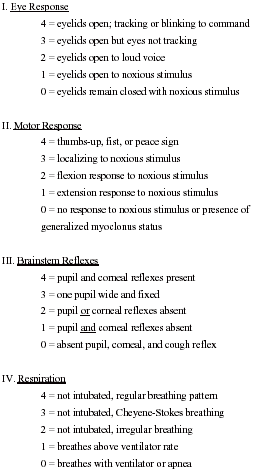The FOUR Score vs the Glasgow Coma Scale
Abstract & Commentary
By John J. Caronna, MD Dr. Caronna is Vice-Chairman, Department of Neurology, Cornell University Medical Center, Professor of Clinical Neurology, New York Hospital. Dr. Caronna reports no consultant, stockholder, speaker's bureau, research, or other relationships related to this field of study.
Synopsis: The probability of in-hospital death was higher for patients with the lowest total FOUR score than for those with the lowest total GCS score.
Source: Wijdicks EF, et al. Validation of a New Coma Scale: The FOUR Score. Ann Neurol. 2005;58:585-593.
The most commonly used scale to assess the status of comatose patients is the Glasgow Coma Scale (GCS).1 The GCS has several well-recognized shortcomings that have limited its prognostic value in patients with coma due to traumatic brain injury2 and in hypoxic-ischemic encephalopathy after cardiac arrest.3 First, because many comatose patients are intubated, the verbal component of the GCS cannot be tested and, second, because abnormal brainstem reflexes and spontaneous breathing patterns that may have important localizing value, as well as indicating the depth of coma, are not included in the GCS.
Wijdicks and colleagues devised a new coma scale, the FOUR (Full Outline of UnResponsiveness), which could provide further neurological detail and predict outcome, yet be easy to use. The FOUR score has 4 testable responses involving eyelid opening, upper extremity motor responses, brainstem reflexes, and respiratory pattern. Each component has a maximal score of 4 (see Table 1).
| Table 1. FOUR Score |
|
|
In order to validate the new coma scale, Wijdicks et al prospectively studied the FOUR score in 120 intensive care unit patients and compared it with the GCS score. There were 9 examiners: 3 neuroscience nurses, 3 neurology residents or fellows, and 3 neurointensivists. The overall reliability was excellent for both the FOUR score and the GCS. The highest degree of agreement was among the neurology residents. Agreement was lowest among the nurses for both scales. The lowest agreement in both the FOUR score and the GCS was with the interpretation of eye opening and, in the FOUR score, with interpretation of brainstem reflexes (pupil light responses and corneal reflexes).
The 120 patients enrolled had an average age of 59 years, range 45-70. The causes of coma included ischemic or hemorrhage stroke (n = 29), traumatic head injury (n = 25), craniotomy for brain tumor (n = 13), aneurysmal subarachnoid hemorrhage (n = 12), post-anoxic encephalopathy (n = 10), and several other conditions, including central nervous system infection, status epilepticus, neuromuscular disease, etc. In this diverse group of patients, the FOUR score provided greater neurological detail than the GCS, recognized a patient with locked-in syndrome, and recorded the evolution of brain herniation syndromes. The probability of in-hospital death was higher for patients with the lowest total FOUR score than for those with the lowest total GCS score.
Commentary
For the neurologist, the FOUR score has significant advantages over the GCS: the FOUR score remains testable in critically ill patients who are intubated, it incorporates essential brainstem reflexes, includes signs suggesting uncal herniation and, therefore, better characterizes the severity of coma in patients with a low GCS score. The inclusion of information about respiratory patterns records the presence of respiratory drive.
In the present study, Wijdicks et al showed that in the hands of skilled observers in an ICU setting, the FOUR score is valid, and provides a more complete appreciation of the severity of coma than the GCS alone. Clinical experience and future longitudinal studies will be needed to establish the interobserver reliability and prognostic value of this new coma scale.
References
1. Teasdale G, Jenett B. Lancet. 1974;2:81-84.
2. Balesteri M, et al. J. Neurol Neurosurg Psychiatry. 2004;75:161-162.
3. Levy DA, et al. JAMA. 1985;253:1420-1426.
Subscribe Now for Access
You have reached your article limit for the month. We hope you found our articles both enjoyable and insightful. For information on new subscriptions, product trials, alternative billing arrangements or group and site discounts please call 800-688-2421. We look forward to having you as a long-term member of the Relias Media community.

